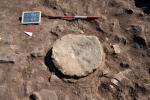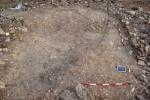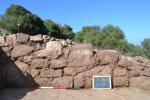Summary (English)
Research undertaken by the University of Milan on Monte Zara, locality of Is Obias (Monastir, CA) confirmed the site’s importance, characterised by a very long chronology (from the nuragic period until the 4th century A.D.). The Archaeological Superintendency for Cagliari and Oristano explored the site between 2011 and 2012.
The site covers an area of c. 2000 m2: evidence emerged within it of earlier structures probably of a cult nature, suggested by finds, out of context, and reused, such as a stone slab for offerings and a fragmentary basin “rotunda con bacile” (Fig. 2). It was surrounded by an imposing dry-stone wall of andesite and calcarenite, with a monumental entrance (c. 6.8 × 4.8 m), built directly on the rock, and a wide walkway. The monumental entrance presented an imposing profile with a double-cornered shoulders in the eastern corner of a limestone threshold with housings for a fixed uprights and a hollow for the closing staff (Fig. 3). The external facing of the entrance was constituted by opus isodomum (Fig. 4.
A preliminary hypothesis suggests four occupation phases at Is Obias. The first period (c. late 9th-7th century B.C.) is attested by the preparation of the area and main walled structures (the curtain walls, monumental entrance with walkway, and a sub-circular room to the north-west: Fig. 5). The second phase (Punic period until the late Hellenistic period: 6th-late 3rd to the 2nd century B.C.), attested by evidence for the reorganisation, probably functional, of some sectors. In the third period (Roman: 1st century B.C. – 4th century A.D.) the sacred area probably lost its primary function (small production area with metal working waste, in the outer corner of the north-west side of the entrance). The fourth period (modern: c. 15th-20th century) saw the definitive abandonment and sporadic occupation on the site.
- Federica Chiesa
Director
Team
- Elena Marazzi
- Giuseppe Lorefice
- Giuseppina Sansica
- Matteo Bormetti
- Mirko Luciano - Centro Studi di Preistoria e Archeologia, Milano
- Simone Dedori
- Gianluca Melandri
- Daniele Cinus
Research Body
- Università degli Studi di Milano
Funding Body
- Università degli Studi di Milano- Dipartimento di beni culturali e ambientali






![Download [PDF]](/excavation/skins/fasti/images/results/download_sml.png)



